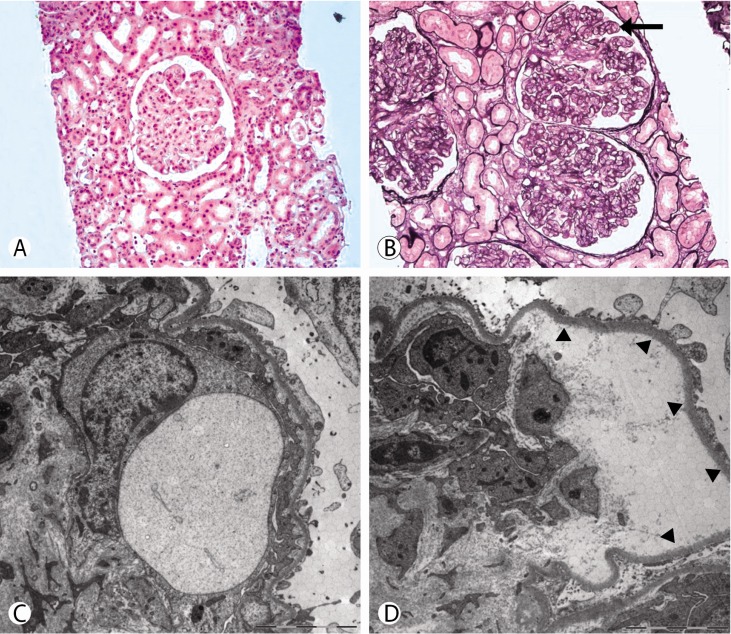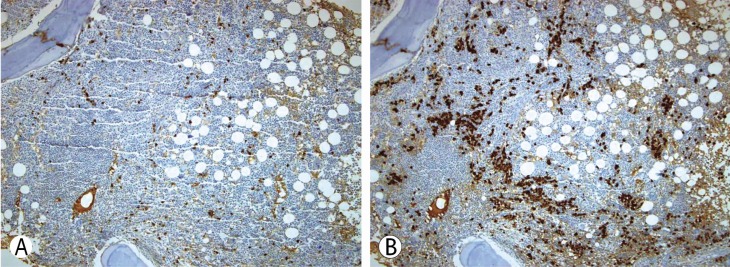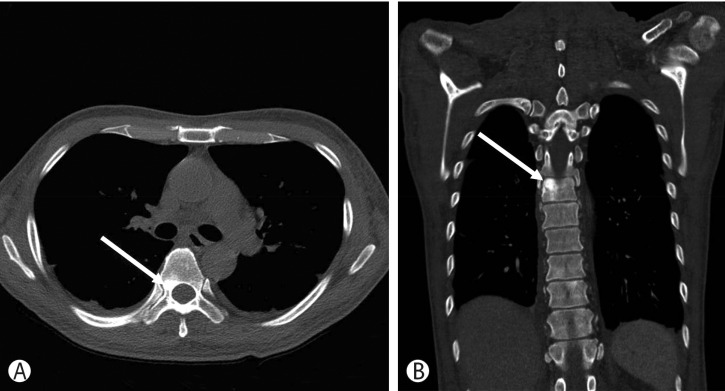Electrolyte Blood Press.
2016 Jun;14(1):5-10. 10.5049/EBP.2016.14.1.5.
A Rare Case of Polyneuropathy and Monoclonalgammopathy with Recurrent Acute Kidney Injury
- Affiliations
-
- 1Department of Internal Medicine, Dongtan Sacred Heart Hospital, Dongtan, Korea.
- 2Department of Internal Medicine, Kangdong Sacred Heart Hospital, Hallym Kidney Research Institute, Seoul, Korea. jieunmd@gmail.com
- 3Department of Pathology, Hallym University College of Medicine, Seoul, Korea.
- 4Department of Laboratory Medicine, Hallym University College of Medicine, Seoul, Korea.
- KMID: 2328424
- DOI: http://doi.org/10.5049/EBP.2016.14.1.5
Abstract
- POEMS syndrome is a rare paraneoplastic syndrome and there are few reports of polyneuropathy and monoclonal gammopathy associated with kidney dysfunction. Here, we report a case of POEMS syndrome with recurrent acute kidney injury (AKI). A 52-year-old man presented with bilateral aggravating paresthesia and latermotor weakness of the lower extremities accompanied by repeated elevation of serum creatinine. The patient was finally diagnosed with POEMS syndrome on the basis of fulfilling the two mandatory major criteria (polyneuropathy and monoclonal gammopathy), one other major criterion (sclerotic bone lesion), and several minor criteria. A renal biopsy was performed to clarify the cause of AKI and showed membranoproliferative glomerulonephritis-like lesions with mesangiolysis and endothelial cell injury. This case illustrates that renal manifestations, not included in the diagnostic criteria for POEMS, can be apparent before various other systemic symptoms.
MeSH Terms
Figure
Reference
-
1. Dispenzieri A. POEMS syndrome: 2014 update on diagnosis, risk-stratification, and management. Am J Hematol. 2014; 89:214–223. PMID: 24532337.
Article2. Higashi AY, Nogaki F, Kato I, Ono T, Fukatsu A. Serial renal biopsy findings in a case of POEMS syndrome with recurrent acute renal failure. Clin Exp Nephrol. 2012; 16:173–179. PMID: 21979795.
Article3. Floege J, Johnson RJ, Feehally J. Comprehensive Clinical Nephrology. 5th ed. Expert Consult-Online: Elsevier Health Sciences;2014. p. 1000–1002.4. Bridoux F, Leung N, Hutchison CA, Touchard G, Sethi S, Fermand JP, et al. International Kidney and Monoclonal Gammopathy Research Group: Diagnosis of monoclonal gammopathy of renal significance. Kidney Int. 2015; 87:698–711. PMID: 25607108.5. Ropper AH, Raje NS, Lawrimore TM, Camelo-Piragua S, Sohani AR. Case records of the Massachusetts General Hospital. Case 7-2010. A 49-year-old man with peripheral neuropathy and ascites. N Engl J Med. 2010; 362:929–940. PMID: 20220188.
- Full Text Links
- Actions
-
Cited
- CITED
-
- Close
- Share
- Similar articles
-
- Severe but reversible acute kidney injury resulting from Amanita punctata poisoning
- A Case of Acute Polyneuropathy with Nephrotic Syndrome Showing Transient Proximal Sensory Conduction Defects
- Spontaneous Tumor Lysis Syndrome Presenting Acute Kidney Injury with Extreme Hyperuricemia and Urinary Stone: A Rare Case of Spontaneous Tumor Lysis Syndrome
- Definition and Diagnostic Criteria of Acute Kidney Injury
- Acute Kidney Injury Arising from Severe Hyperemesis Gravidarum: Case Report with a Review of Literatures




